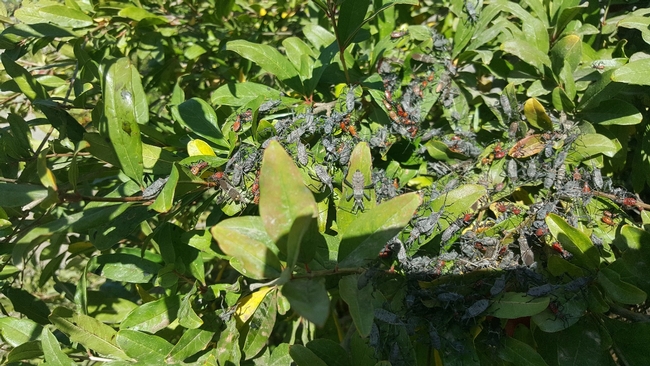Cold winter temperatures can reduce populations of leaffooted bug, Leptoglossus zonatus (Dallas), by ~50 to 80%. But unfortunately, it takes a cold year much like occurred in January of 2007 where daytime temperatures remained low and nighttime temperatures reached about 20° F for several hours. In other words, ouch for the citrus crop. Fall and winter temperatures of 2016 / 2017 were ideal for leaffooted bug and the growing season started out with large populations. I need to add that we do not fully understand if the wet winter positively affected populations - it certainly did not have a negative impact.
Monitoring and managing leaffooted bug presents an IPM challenge. In the fall between September and mid-November, the species produces a full generation; certainly, on pomegranate and although I have not observed it, also on desert willow. In most years, adults have moved from those host plants by late December to protected overwintering sites such as Mediterranean fan palm and Italian cypress trees. In early March leaffooted bug leave overwintering sites to feed on what happens to be available at the time i.e. almonds and subsequently pistachio.
The IPM challenge is that we do not have an effective monitoring tool to detect the bug when they make their initial entrance into almond in spring and pistachio in early summer. And moreover, once leaffooted bug is detected, pyrethroids offer the best management option – not necessarily the best IPM option.
Given the importance of pomegranate in the life cycle of leaffooted bug, PCAs and growers need to concentrate monitoring efforts on that crop during September through October, especially focusing on unmanaged orchards and hedgerows near almond and pistachio orchards. If populations are found they will consist mainly of immature stages and there are two management options, clothianidin and pyrethrins. The caveat is that those compounds have only contact activity; coverage must be good and the insecticides will likely not have a great impact on adults because they will spook and fly away before being sprayed.
At this time, pistachios have passed the most vulnerable stage for leaffooted bug damage but can still suffer some damage and should be monitored and treated if bugs are found. The UC Statewide IPM Program provides a few monitoring recommendations focusing on damaged nuts and nymphs. Adults can be monitored for by visually searching tree canopies for about 15 – 20 seconds each. Concentrate searches to the sunny side of the canopy and focus attention on the nut clusters.
Unfortunately, the treatment options with any residual activity are limited to pyrethroids. Producers have begun gearing up for “hull split” navel orangeworm sprays. Note however, that non-pyrethroid compounds such as methoxyfenozide, chlorantraniliprole, spinetoram do not have any activity against leaffooted bug or other large bugs.
Insecticide use should occur only if monitoring indicates the presence of leaffooted bug and/or its feeding damage. Apply insecticides only after considering the potential risks of the compound to beneficial organisms, including bees and biological control agents, and to air or water quality. For more information on these topics please consult the UC IPM Pest Management Guidelines for Almonds at http://ucipm.ucanr.edu > Agricultural pests > Almond
Photo Caption:
Fig. 1. Aggregation of leaffooted on pomegranate in early October of 2016. The aggregation is comprised mostly of fifth instar.
Attached Images:
